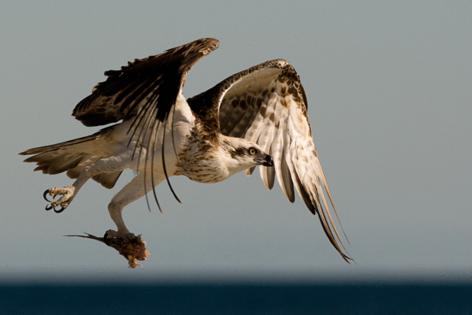Osprey population 'near complete collapse' on Virginia's Eastern Shore, scientists report
Published in Science & Technology News
The osprey population on the Eastern Shore of Virginia has dropped to just 18 birds, and scientists at Williams & Mary’s Center for Conservation Biology say it’s a sign of an “early complete collapse” of the species.
In 1975, one of the first aerial surveys for ospreys, there were 68 breeding pairs on the Eastern Shore. In 1987, when the area was surveyed again, the population was about 83 pairs. Now, researchers have found only nine pairs from Fisherman Island to the Chincoteague Causeway.
“Beginning in the late 1990s, we have observed an ongoing loss of pairs from structures that were used consistently for nesting over the previous 25 years,” said Bryan Watts, director of the Center for Conservation Biology. “The number of vacant territories has grown over time, with many having been lost over the past decade.”
The reason for the loss is unclear. While habitats have changed since population surveys began in the ’70s and ’80s, adequate areas for nesting are still widely available. One theory is bald eagles. Their population has more than tripled over the past 30 years, but the population density of eagles continues to be “a small fraction” of what has been found in the upper tributaries of the Chesapeake Bay, where ospreys continue to thrive.
Watts said the likely cause is the decline of the fish that ospreys eat. At this time, no osprey diet studies have been conducted within the area, and scientists know very little about trends in fish availability on the Eastern Shore.
“During the 1970s and 1980s the highest density of nesting pairs was skewed to the southern portion of the area around Fisherman and Mockhorn Islands,” Watts said. “These birds could be observed flying out to the mouth of the Chesapeake to forage. Pairs have declined by more than 90% within this portion of the study area.”
In September, the center reported that baby ospreys are facing a greater threat of starvation because there are fewer menhaden in the Chesapeake Bay area. In the report, researchers compiled breeding results in 511 osprey pairs in a dozen study areas, including in Hampton Roads. Breeding pairs were monitored throughout the nesting season, or from March to August, to measure success.
To maintain population, ospreys need 1.15 chicks per pair of breeding ospreys. The collective reproductive rate for the population being monitored was 0.55 young chicks per pair.
Areas where ospreys relied on menhaden as a primary food source saw the biggest deficits in reproductive rates. Areas where catfish and gizzard shad were the main source of food had sustainable osprey populations.
In Virginia Beach, breeding performance for ospreys had a “minor deficit,” or a reproductive rate between 0.8 to 0.9 young per breeding pair. Around the Elizabeth River in Norfolk and Portsmouth and on the Eastern Shore, the rate had a “moderate deficit,” or 0.6 to 0.8 young osprey per pair. Areas on the Peninsula and Northern Neck had a “major deficit.”
_____
©2025 The Virginian-Pilot. Visit pilotonline.com. Distributed by Tribune Content Agency, LLC.







Comments